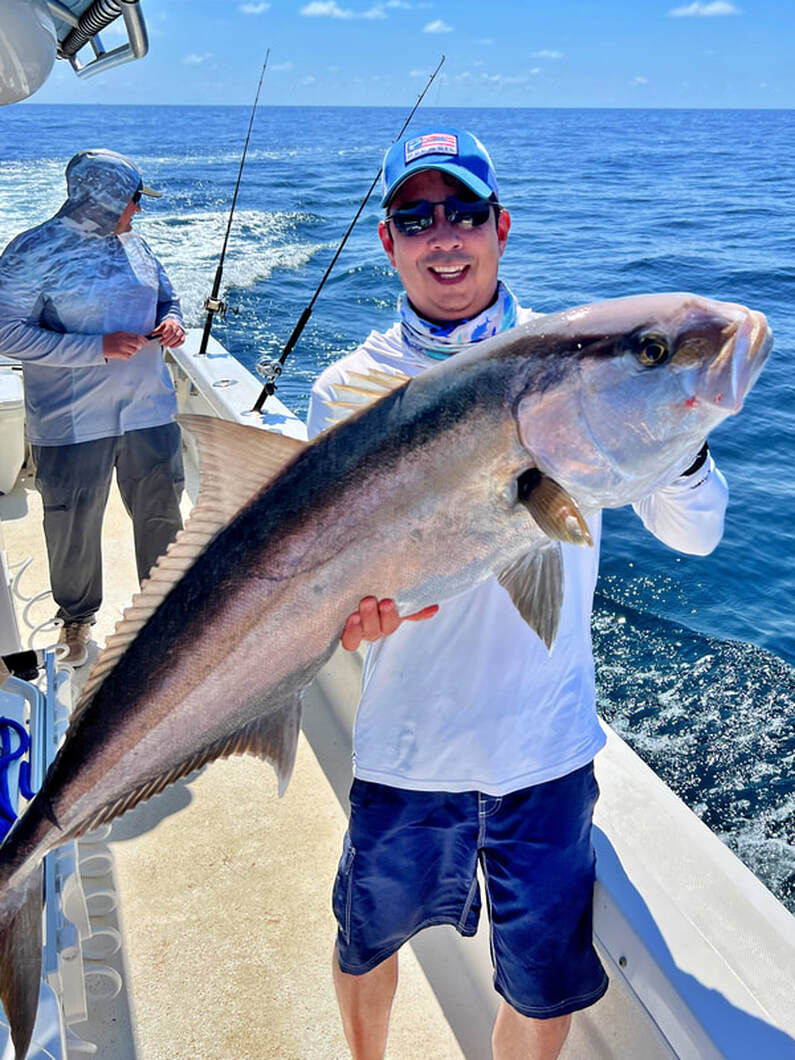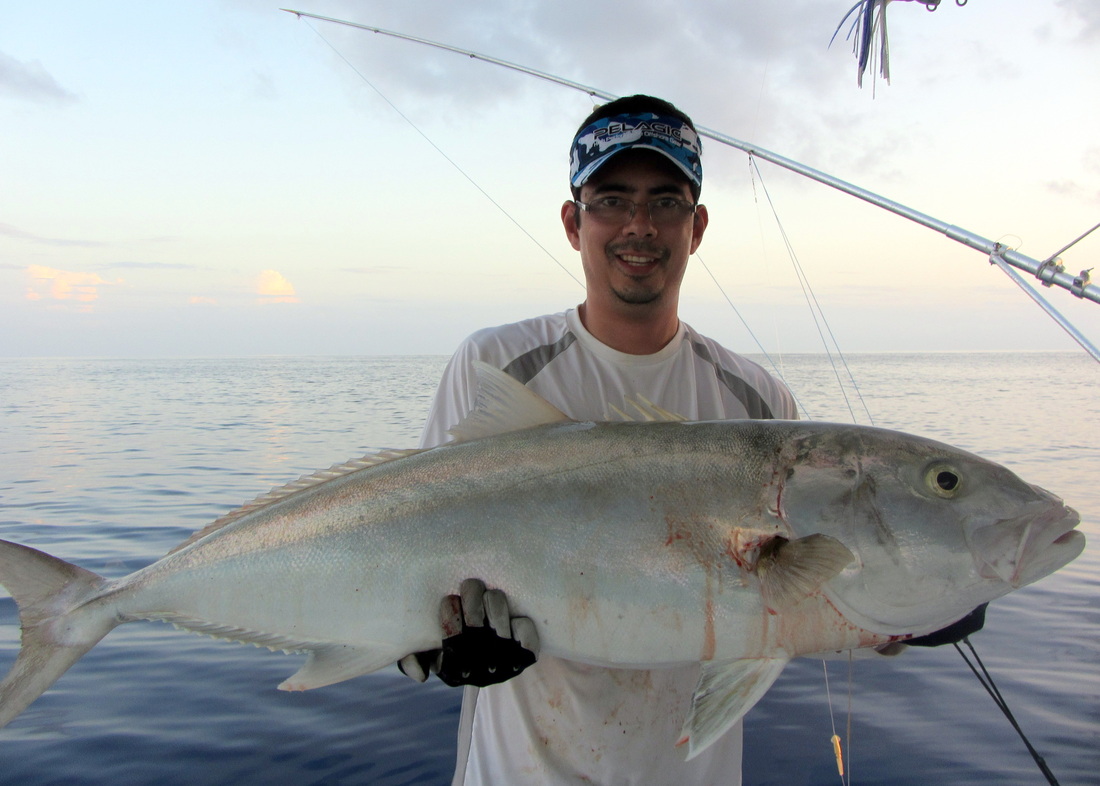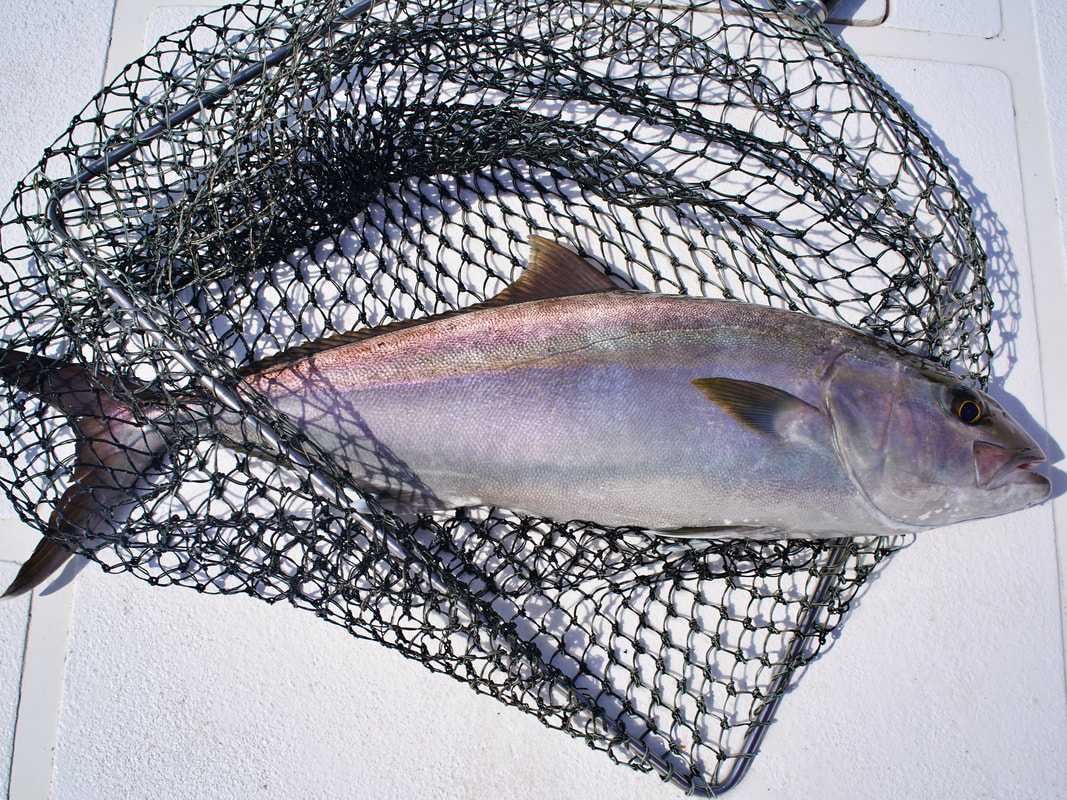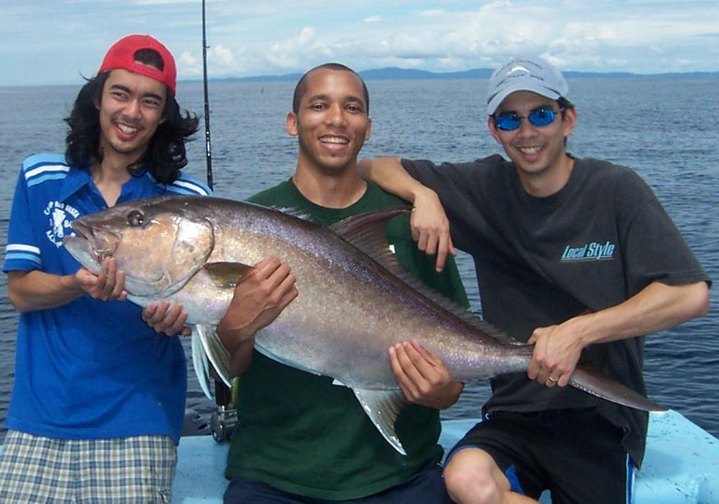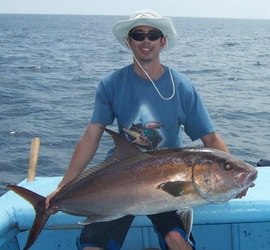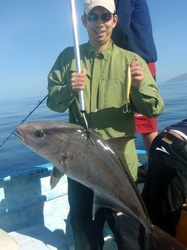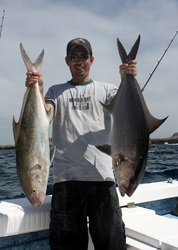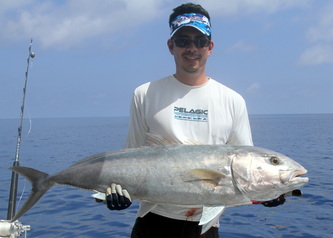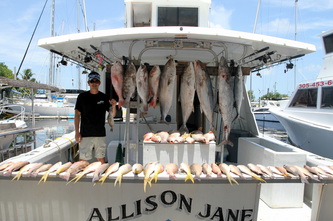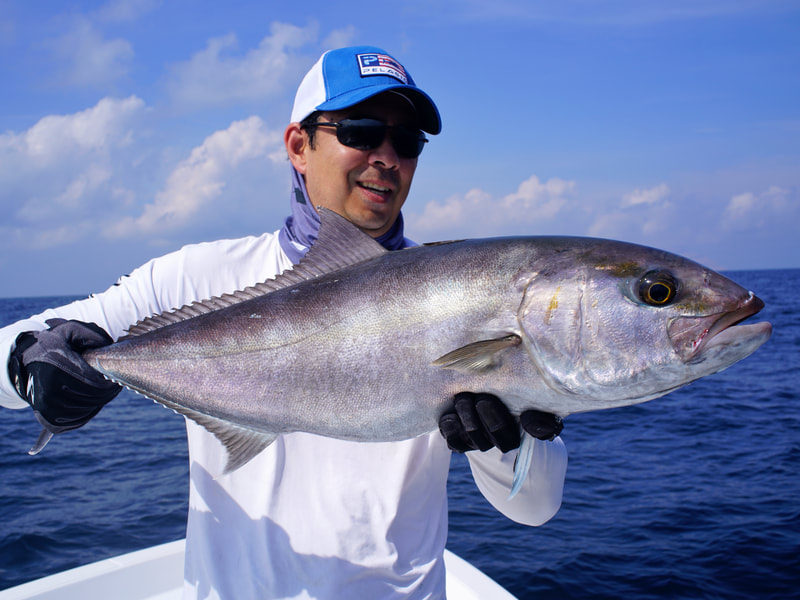Amberjack
Seriola dumerili
Home
Other Species
Amberjack Description
Amberjack, or “Reef Donkeys”, are not a great looking fish but they sure pull hard. In many parts of Latin America they are called “Pez Fuerte” which literally means “Strong Fish”. They are found in tropical reefs in both the Atlantic and Pacific. They sometimes come up to the surface but are generally found nearer to the bottom anywhere from 60-250 feet. They are structure-oriented, so natural and artificial reefs are good places to find them. Larger ones are generally found deeper, but fish of any size can sometimes come up to the surface.
Some Amberjack migrate, while others stay in the same area all year long. They spawn in spring, whatever time of year that is in the place they are living.
Amberjack Pound for Pound Fight Rating - 8 out of 10 on the Saltwater Scale
Like all Jacks, Amberjacks pull very hard for their size. As one of the largest members of the Jack family, they have a lot of size to pull with. They are not as likely to brick you in the rocks as, say, the Cubera Snapper, but they will bust you off if you let them get into the wrecks and rocks where they live. Landing a few big Amberjack in a row will tire you out quick even on heavy tackle. People not used to pulling on big fish run the risk of getting rag-dolled by these reef donkeys.
Amberjack Culinary Rating - Medium
Unlike many members of the Jack family, they are actually pretty tasty to eat. They have very firm meat that holds up well when cooked a variety of different ways. Unfortunately, their flesh sometimes contains parasitic worms. These are rendered harmless by cooking, but are unappetizing to say the least. They also can carry ciguatera toxin in some areas. That said, all the ones I've eaten have been delicious.
Amberjack Tackle
If you are targeting large adult specimens (and what else would you target really?) I recommend conventional gear with 50lb braid lines or more. They don't have teeth, so wire leaders are not necessary. Although they are not as adept at bricking you in the rocks as Snappers or Groupers, you do need to pull hard to ensure that doesn’t happen. An Accurate BX2 or BX reel is an excellent choice. Click here for tackle recommendations.
Amberjack Techniques
Amberjack readily eat lures and bait fished either at the bottom or at whatever depth they happen to be at. They can sometimes be coaxed to the surface with chum.
Amberjack Lures
Amberjack readily eat metal jigs, both the butterfly jig-type and the traditional West Coast Iron like Salas 6X. If you can chum them up near the surface they will take a variety of topwater and subsurface lures including spoons, jerkbaits, plastics, etc.
Amberjack Baits
Any decent sized live baitfish should work. These guys are not that picky. Small fish in the jack family such as blue runner type baits are always good. Pinfish work in Florida and other parts of the Caribbean. Squid work well also. They will not hesitate to attack large baits. I once had a 65lb Amberjack attack a 10lb Yellowfin Tuna I was reeling in during a trip to Panama. We dropped back a Skipjack and caught it.
Where to get the big Amberjack
These guys are pretty widespread. Panama has some big ones on the Pacific side and there are some big ones in Kona. They are found all over the tropics and as long as an area doesn't get too much fishing pressure there should be some big ones.
Other Amberjack Resources
The above barely scratches the surface on how to catch Amberjack. The resources below will help you catch them:
I've never fished with them, but I understand these guys can put you on them in Panama: www.pescapanama.com
These guys can put you on them in Florida: www.anotherkeeper.com, www.majesticseascharters.com
Seriola dumerili
Home
Other Species
Amberjack Description
Amberjack, or “Reef Donkeys”, are not a great looking fish but they sure pull hard. In many parts of Latin America they are called “Pez Fuerte” which literally means “Strong Fish”. They are found in tropical reefs in both the Atlantic and Pacific. They sometimes come up to the surface but are generally found nearer to the bottom anywhere from 60-250 feet. They are structure-oriented, so natural and artificial reefs are good places to find them. Larger ones are generally found deeper, but fish of any size can sometimes come up to the surface.
Some Amberjack migrate, while others stay in the same area all year long. They spawn in spring, whatever time of year that is in the place they are living.
Amberjack Pound for Pound Fight Rating - 8 out of 10 on the Saltwater Scale
Like all Jacks, Amberjacks pull very hard for their size. As one of the largest members of the Jack family, they have a lot of size to pull with. They are not as likely to brick you in the rocks as, say, the Cubera Snapper, but they will bust you off if you let them get into the wrecks and rocks where they live. Landing a few big Amberjack in a row will tire you out quick even on heavy tackle. People not used to pulling on big fish run the risk of getting rag-dolled by these reef donkeys.
Amberjack Culinary Rating - Medium
Unlike many members of the Jack family, they are actually pretty tasty to eat. They have very firm meat that holds up well when cooked a variety of different ways. Unfortunately, their flesh sometimes contains parasitic worms. These are rendered harmless by cooking, but are unappetizing to say the least. They also can carry ciguatera toxin in some areas. That said, all the ones I've eaten have been delicious.
Amberjack Tackle
If you are targeting large adult specimens (and what else would you target really?) I recommend conventional gear with 50lb braid lines or more. They don't have teeth, so wire leaders are not necessary. Although they are not as adept at bricking you in the rocks as Snappers or Groupers, you do need to pull hard to ensure that doesn’t happen. An Accurate BX2 or BX reel is an excellent choice. Click here for tackle recommendations.
Amberjack Techniques
Amberjack readily eat lures and bait fished either at the bottom or at whatever depth they happen to be at. They can sometimes be coaxed to the surface with chum.
Amberjack Lures
Amberjack readily eat metal jigs, both the butterfly jig-type and the traditional West Coast Iron like Salas 6X. If you can chum them up near the surface they will take a variety of topwater and subsurface lures including spoons, jerkbaits, plastics, etc.
Amberjack Baits
Any decent sized live baitfish should work. These guys are not that picky. Small fish in the jack family such as blue runner type baits are always good. Pinfish work in Florida and other parts of the Caribbean. Squid work well also. They will not hesitate to attack large baits. I once had a 65lb Amberjack attack a 10lb Yellowfin Tuna I was reeling in during a trip to Panama. We dropped back a Skipjack and caught it.
Where to get the big Amberjack
These guys are pretty widespread. Panama has some big ones on the Pacific side and there are some big ones in Kona. They are found all over the tropics and as long as an area doesn't get too much fishing pressure there should be some big ones.
Other Amberjack Resources
The above barely scratches the surface on how to catch Amberjack. The resources below will help you catch them:
I've never fished with them, but I understand these guys can put you on them in Panama: www.pescapanama.com
These guys can put you on them in Florida: www.anotherkeeper.com, www.majesticseascharters.com
